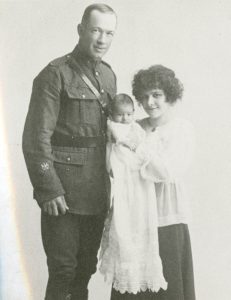Above: Patients and nurses at a World War I convalescent hospital in 1918 (SPRA 1969.59.331)
Following the end of the First World War, numerous ships crossed the Atlantic carrying a new type of human cargo – war brides. These women (mostly of British origin) had fallen in love with the soldiers they met at dances, hospitals, or perhaps even in their parents’ homes, where servicemen were often billeted. The couples married in simple ceremonies, then perhaps had a few days to spend together before the newlywed soldier was sent back to France.
After the Armistice and demobilization of the troops, the young wives boarded ships bound for Canada, often without their husbands, who were transported home on separate troop ships. It is unlikely that the brides fully understood the ruggedness of the land they were going to call home, or expected the challenges it would present. While there are no official figures, it is estimated that at least 35,000 war brides had immigrated to Canada by August of 1919. Most of them exhibited great courage and tenacity as they endured – and even thrived under – the hardships they faced here.
In the early 1900s, it was uncommon for a woman to be called by her given name by anyone but close friends and family. This makes researching war brides rather difficult, as news clippings (and even community books, which were published much later) simply refer to a ‘Ms. Jones’ or ‘Mrs. J. Smith’. Soldiers’ service files (digitized by Library and Archives Canada) are often our only source of information regarding their wives, since army records usually include the full name and address of the pay recipient and next-of-kin.
One can almost follow the developing relationship between a soldier and his sweetheart through his service file. Most often, hospital records will appear, indicating that the young man was wounded and sent to England for recovery. This is shortly followed by a note stating he had been ‘granted permission to marry.’ Obviously he had fallen in love with his nightingale. On the occasion that a healthy soldier found a wife, it likely occurred while he was on leave in England, or perhaps he had married the daughter of his French or Belgian billets. Shortly after being granted permission to marry, a new will was made out (with the wife’s name on it), and near the same time, the pay sheet confirmed the change of next-of-kin. By following these leads, a number of war brides’ stories have been uncovered.
On slightly more rare occasions, these new brides also became mothers before coming to Canada. Such was the case of Alfred Collins and his wife Winnifred Emily. Though it is uncertain when and where Alfred and Emily met, Alfred had leave in September 1917, and in April of 1918 he was hospitalized with influenza. It is quite possible that they became acquainted on one of these occasions. In October 1918, Alfred was granted permission to marry, and shortly thereafter he was given a week’s leave, presumably for their honeymoon. During this leave, the war ended and Alfred did not return to France. By the time they were ready to return to Alfred’s home in Spirit River, the Collins were parents to a baby daughter named Betty.
The clues found in the digitized service files have been invaluable to the research of our soldiers, their wives, and what awaited them following the war. Many of the nurses on our memorial would not have been found if not for the unique documentation of these love stories.
Guest article by Kaylee Dyck, originally featured in the March 2018 issue of Telling Our Stories.

